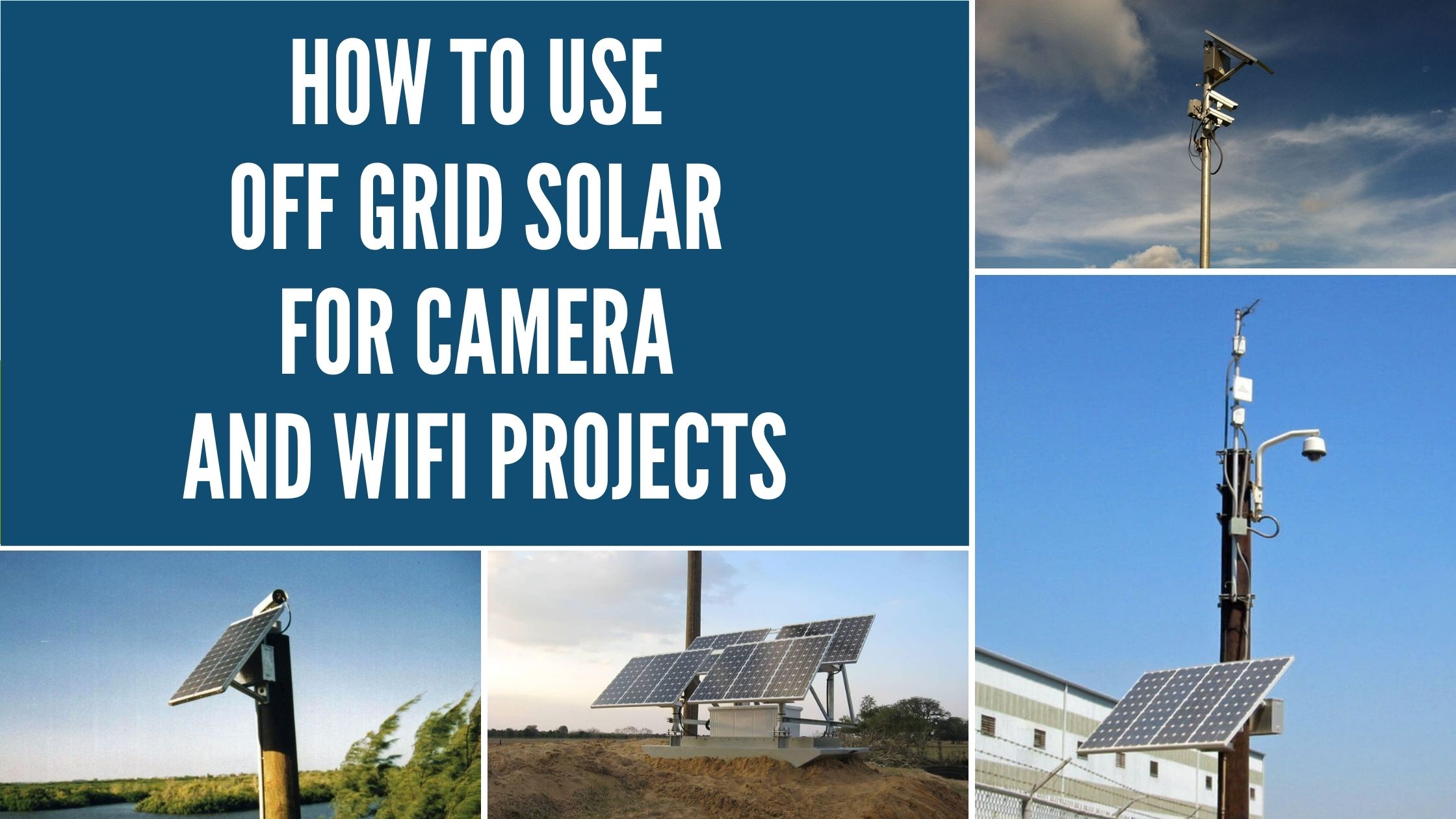How To Use Off Grid Solar for Camera and WiFi Projects

Contents
Off grid solar power is an increasingly popular form of renewable energy that can provide a reliable and cost-effective source of electricity for camera and WiFi applications. By harnessing the sun's energy, off grid solar power systems can be used to power cameras, routers, access points, and other necessary equipment for the operation of a camera or WiFi network. This type of renewable energy is not only cost-effective but also environmentally friendly. In this article, we will discuss what off grid solar power is and how it can benefit camera and WiFi applications.
In this post, we will go over why solar can be beneficial to a camera or WiFi application, why you should consider using solar for your next project, how to calculate the solar requirements, and some tips and tricks for a successful solar project.
What is Off Grid Solar Power and How Can it Benefit Camera & WiFi Applications?
Off-grid solar power is the use of solar energy to generate electricity without relying on the traditional grid. It is a cost-effective and reliable way to generate electricity in remote locations where there may be no access to the main grid.
Off-grid solar power can benefit camera and wifi applications by providing a more reliable and cost-effective source of energy. With off-grid solar, cameras and wifi applications can be powered in remote locations, such as rural areas or mountainous regions, where connecting to the main grid may not be possible. Additionally, off-grid solar can provide a more sustainable solution for powering these applications since it does not rely on nonrenewable sources of energy like fossil fuels. Finally, it provides added safety and security as it does not rely on the energy grid, making areas prone to energy disruptions more secure.
Why You Should Consider Going Off the Grid for Your Digital Devices
It's no secret that the world is becoming increasingly digital, and with this comes a need to use digital devices. However, there are growing concerns around the environmental impact of using these devices and the potential for data breaches.
Fortunately, off-the-grid solutions available can reduce our reliance on traditional energy sources while still allowing us to stay connected. Going off the grid for our digital devices can reduce our carbon footprint and increase our security. We can also benefit from renewable energy sources such as solar and wind power, which provide clean energy without compromising on convenience.
How To Calculate the Amount of Solar Power Required for Your Camera & WiFi Applications
To calculate the amount of solar power required for a camera and WiFi application, you'll need to consider the following factors:
- Power Consumption: Determine the power consumption of your camera and WiFi equipment by checking their specifications.
- Daily Usage: Estimate the daily usage time for your camera and WiFi equipment.
- Installation Location: The system installation location allows the specifier to determine how much sun is available at a specific location.
- Solar Panel Output: Select solar panels with an output that meets or exceeds the power consumption of your camera and WiFi equipment.
- Battery Capacity: Choose a battery with enough capacity to store the solar panels' energy and power your camera and WiFi equipment during periods of low or no sunlight.
Why You Should Use DC Power Equipment
Most camera and WiFi systems can be purchased in either AC or DC power. Most people jump on the AC systems; however, this is not beneficial when designing an off-grid solar system. Instead, opting for more efficient DC powered systems would allow for the system to operate directly from the solar power assembly without the need for inverters. Other factors include:
- Efficiency: Direct current (DC) systems are more efficient than alternating current (AC) systems in converting and transmitting energy, as there are fewer energy losses in DC transmission compared to AC transmission.
- Simplicity: A DC powered system removes the need for an inverter, simplifying the overall system and reducing the cost, size, and weight of the equipment.
- Matching Energy Sources: Most solar panels produce direct current, so using a DC system allows for a direct match between the energy source and the load, reducing the number of conversions and increasing efficiency.
- Compatibility: DC powered equipment is often designed specifically for use with renewable energy systems, making it easier to integrate into a solar power system.
- Improved Durability: DC systems have fewer components than AC systems, making them less prone to failure and improving the system's overall reliability.
By combining these factors, you can determine the size of the solar panel system required for your camera and WiFi application to ensure system operation and longevity.
What Types of Equipment are Needed to Go Off Grid with Solar Power?
The following equipment is typically required to go off-grid with solar power:
- Solar Panels: The solar panels generate electricity from the sunlight. The amount of solar panel energy required for a specific project is determined by the information provided to the specifier in the section above. Detailed specifications are required for solar sizing.
- Battery Bank: The battery bank stores the electricity generated by the solar panels during the day for use by the system. All equipment will operate directly off the power stored in the battery, regardless of the time of day the equipment is operating.
- Charge Controller: The solar charge controller regulates the flow of electricity from the solar panels to the battery and prevents overcharging. The controller also operates the load and regulates the battery discharge rate as well.
- PoE – Power over Ethernet: The PoE provides the correct output power to the devices, regardless of the input power from the solar system. The PoE is important when dealing with multiple devices on a single pole, such as a camera that transmits its information over a WiFi signal using a repeater.
- Mounting System: To securely mount the solar panels on a roof or other structure, the solar mounting system needs to be designed for the specific type of installation. Flat mounting of the solar panel is not generally recommended and standard brackets, like a SEPCO 45 degree bracket, is more standard.
It is important to select equipment that is compatible with each other, as well as suited to the specific requirements of your off-grid solar power system. It is also recommended to consult with a professional for a proper design and installation of the system.
Top Tips For Installing an Off Grid Solar System to Power Cameras and Wi-Fi Devices
Here are some top tips for installing an off-grid solar system to power cameras and Wi-Fi devices to ensure you have the right system for the job:
- Assess Energy Needs: Calculate the energy consumption of all devices and equipment to determine the size of the solar panel system required.
- Consider Location: Choose a location with adequate sunlight exposure and access to battery storage.
- Select Appropriate Components: Choose high-quality components that are compatible with each other, including solar panels, battery bank, charge controller, PoE, and cables.
- Proper Battery Sizing: Select a battery bank with enough capacity to store energy for periods of low or no sunlight.
- Proper Panel Orientation and Tilt: Ensure that the solar panels are mounted at the correct orientation and tilt to maximize energy generation.
- Use Quality Wiring and Connections: Use high-quality wiring and connections to ensure safe and efficient energy transfer.
- Hire a Professional: Consider hiring a professional for installation to ensure proper design and installation of the system.
By following these tips, you can ensure that your off-grid solar system is properly installed and will meet the energy needs of your cameras and Wi-Fi devices.
In conclusion, using off-grid solar power for camera and Wi-Fi applications provides a reliable and sustainable source of energy. It eliminates the need for a traditional electrical grid and provides independence from power outages and fluctuations in electrical prices.
By harnessing the sun's power, an off-grid solar system can provide a clean and renewable energy source for your camera and Wi-Fi devices, reducing your carbon footprint and your dependence on fossil fuels. With proper design and installation, an off-grid solar system can provide long-term savings and peace of mind, ensuring that your camera and Wi-Fi devices are powered even in remote or off-the-grid locations.

